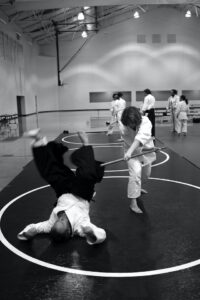What it comes to ukemi, I believe that aikido has a serious problem that the vast majority of people aren’t even aware of. It’s a pretty simple one and to find out what it is let’s consider the standard aikido class. As we consider this, reflect on the moment where we teach the ukemi.
The Standard Class
- It begins with the students lining up and everyone bows.
- There’s a warm-up which will include some stretching, rolling and footwork movements.
- After the warm up the class will progress onto techniques in which:
- Everyone lines up.
- The instructor picks an uke.
- The instructor demonstrates the technique on the uke several times. They may make an observation or two of a specific point of focus for the lesson.
- The students will pair up and try to copy what they have seen the instructor do.
- At the end of the class there may or may not be a cool down involving some stretching.
I have trained in enough dojo’s in enough countries to feel completely comfortable stating that this is how the vast majority of aikido classes are taught. There are variations on this naturally, some will include meditation some won’t for instance, but they will predominantly follow this gentle curve of compliance.
What’s Wrong With That?
There are numerous aspects of this class structure that I take issue with, in some circles my rant on aikido warm-ups is becoming legendary (or ‘stay colds’ as I prefer to call them). What I specifically want to look at here is 3.3 – ‘The instructor demonstrates the technique on the uke several times.’
This is the traditional way that aikido has been taught. The unfortunate thing about tradition is that just because it’s always been done that way doesn’t mean it is the best way to do something, merely that a different way has not been considered. Something becomes a tradition because it was previously thought to be the best way to do it. Unfortunately knowledge advances and often times those traditional methods become very outdated and in some cases a hinderance to the goal. They can be useful to know as a fall back system but if a pilot suddenly turned off the aeroplanes GPS and pulled out a chart and compass I’d be a little concerned. It’s not that this is ineffective, it’s just that there are better systems available.
The aikido teaching method is similar to this. What was once an accepted method of transmitting the knowledge is still considered to be a good one. Unfortunately there have been a large number of advances in various fields that relate to what we’re doing. These fields include coaching techniques, teaching methodology, and sports science.
When you watch a standard aikido class it’s as if the last 70 years of advancement in these areas by-passed us. For now let’s just consider the most basic and flawed aspect of the teaching method. I say flawed but perhaps that’s the wrong term. Ill-considered might be a better one.

The Importance of Ukemi
I’ve never come across an aikidoka that is unaware of the importance of ukemi. Most of the ones I’ve talked to about it agree that it is at least as important as performing the techniques. Without good ukemi you can’t do good aikido is something that people generally agree on.
If that’s true, and I believe it is, why don’t the instructors teach the ukemi as well? This is so blindingly obvious it baffles me more people don’t raise it or just do it. In over two decades of training around the world I can only name one person that would routinely demonstrate the ukemi (Henry Kono, though I never personally saw it as I only trained with him once) and one other that does but I don’t think it’s a common occurrence for them (Osamu Obata Shihan, it was amazing to see).
By teaching the ukemi I don’t mean that they teach people how to roll or breakfall. What I mean is that when they demonstrate a technique they reverse roles and the instructor takes the ukemi and explains how to do it. What the uke should be doing to promote the principles that the nage should be working on.
It Makes A Difference
This is so very simple yet results in such a massive change. When I realised this glaring omission I started to demonstrate both sides of the technique. The resulting pace of learning my students displayed was an order of magnitude greater than before.
It’s often said that uke is the teacher of nage, but if we don’t teach uke what to do how can they? What chance do either of them actually have?
Of course, the argument is that the students should be watching both uke and nage during the demonstration, but that’s not what happens. Everybody watches the instructor. After all, they’re the one teaching. If you’re watching the uke you don’t see what you’re supposed to be doing.
I don’t consider this to be a malicious act either. I think it’s a result of tradition (we’ve always taught this way) and lack of thought towards what we’re actually doing. It’s simply never occurred to the vast majority of aikidoka to ask the question, ‘Why don’t we demonstrate both parts?’ When you start thinking about it you realise that there isn’t actually a good answer.
If you’re a teacher, start teaching the ukemi as well. It’ll improve not only your aikido but your students as well. If you’re a student, be bold, ask your instructor to demonstrate the ukemi (though they probably won’t thank you for it). You don’t have to ask them while they’re teaching, do it during the training part if you prefer.
Teach the ukemi.
If you can afford it, and would like to help out,
consider donating some brain fuel!
Also, if you enjoyed this post you can find further insights in this book.